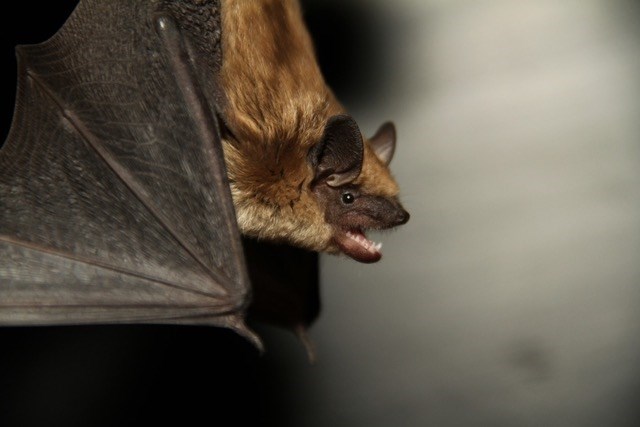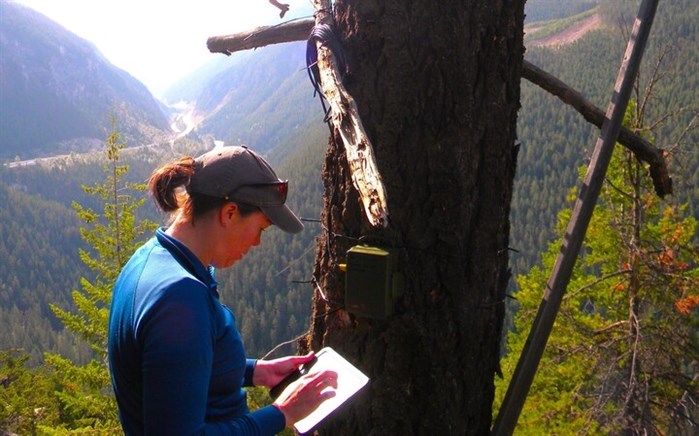
FILE PHOTO
Image Credit: SUBMITTED/Okanagan Community Bat Program
April 02, 2023 - 7:30 AM
Bats eat bugs – including mosquitos – in huge amounts. Some can eat more than their own weight in insects each night.
That’s why they’re so important to the environment.
“If they were suddenly to not be part of our ecosystem we could see problems with pest numbers that could affect agriculture and forestry,” bat researcher Samantha Gidora told iNFonews.ca. “Maybe people would have to use more pesticides.”
READ MORE: Forget pesticides; get a bat home to fight mosquitoes this summer
Which is why she’s studying bats for her Masters degree in environmental science at Thompson Rivers University.
“Bats are a super fascinating creature to study because they’re sort of an underdog, misunderstood animal,” Gidora said. “They’re a creature of the night so less obvious for us to see. It’s sort of fun because you have to use some gadgets and tools to help study them.”

Thompson Rivers University bat researcher Samantha Gidora attaches a bat monitor to a tree.
Image Credit: SUBMITTED/Samantha Gidora
The typical tool for studying bats is a device that can record them as they send out their echolocation “clicks.”
“When you can record their calls in a big open space – the different frequencies they call at vary by species – you can use that to sometimes tell which species or type of bat has been calling,” Gidora said. “But if you’re recording them in a mine shaft, their calls are really hard to tell apart and they’re echoing. That interferes so it’s harder to get that detail on which type of bat it was.”
A low tech option is to just go to their roost in places like trees or crevices, where some species live, to observe and count them. But that’s not always feasible for those species that hang out in caves or mines.
“They can be really dangerous to survey,” Gidora said. “It’s not like you can just walk in and count all the bats. Sometimes you can’t go in because it’s unsafe.”
Her study will use echolocation devices but also a relatively new technology called environmental DNA. It collects air samples that can be analyzed for bat DNA so it is, in a sense, “smelling” out the bats even though it’s not an odour that’s being tested for.
The first part of Gidora's study will be to test the technology with bats in artificial roosts just to make sure it works.
“The second part is a broader field validation study where I’ll be going out to several inactive underground mine sites in the Kamloops region,” Gidora said.
To find the sites, she’s being helped by Peachland mine researcher Ron Barkwill who will scout out a couple of dozen sites for her to look at this summer.
READ MORE: iN VIDEO: All you ever wanted to know about abandoned mines in B.C.
It’s important that the mines be accessible to Gidora but those that are heavily visited are not likely to make her short list because people may damage or steal the monitors.
The plan is to place the monitors high enough in the mines this fall to detect bats flying in and out, then leave them over the winter to be collected next spring.
Gidora will be using acoustic recorders as well but they can’t detect whether a number of bats are using a site or just a few of them are flying in and out.
The hope is that the DNA sampling will not only detect the number of bats but the species of bat as well.
Gidora will be evaluating the two technologies to see if one is better or if they are both needed to complement each other.
Another key element of the research is to see if the air samples can also be tested for the fungus that causes white nose syndrome that is deadly to bats.
“The fungus is surrounding us but it hasn’t yet been detected in B.C.,” Gidora said.
It’s killing bats in some nearby states like Montana, Idaho and Washington. While it has been detected in Alberta and Saskatchewan, it has not yet killed bats in those provinces.
Because of the importance of bats and the dangers of white nose syndrome there are a number of programs monitoring their health through swabs and guano sampling.
Anyone who finds a dead bat is asked to report them to B.C. Bats where they can also get more information on the flying mammals.
To contact a reporter for this story, email Rob Munro or call 250-808-0143 or email the editor. You can also submit photos, videos or news tips to the newsroom and be entered to win a monthly prize draw.
We welcome your comments and opinions on our stories but play nice. We won't censor or delete comments unless they contain off-topic statements or links, unnecessary vulgarity, false facts, spam or obviously fake profiles. If you have any concerns about what you see in comments, email the editor in the link above.
News from © iNFOnews, 2023